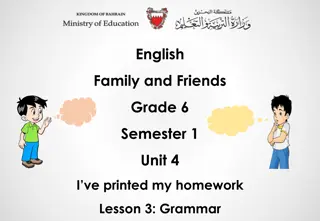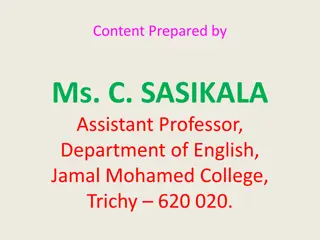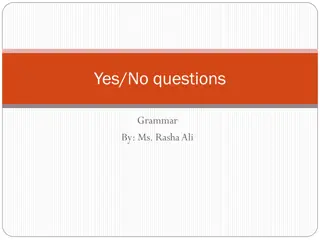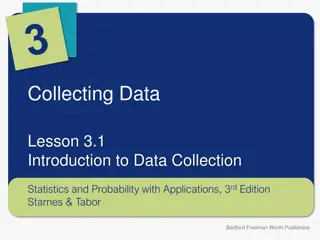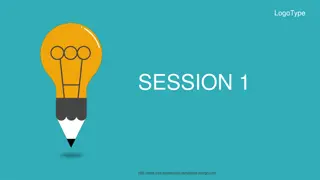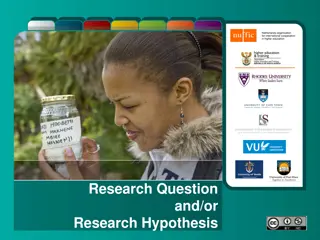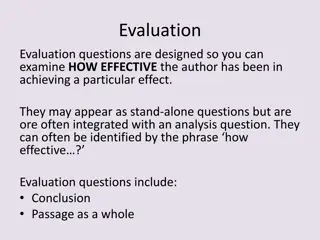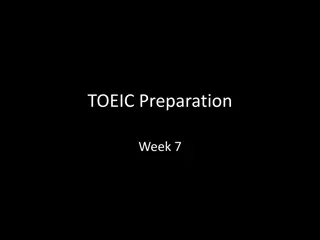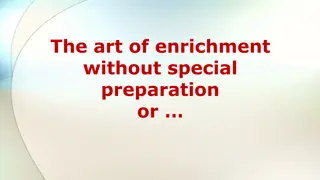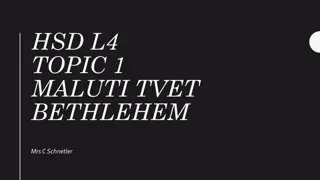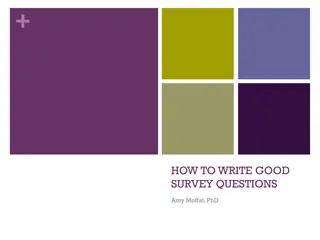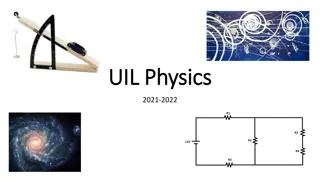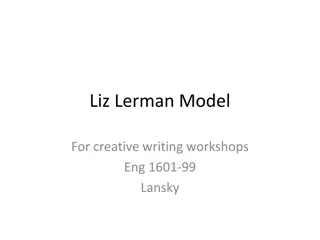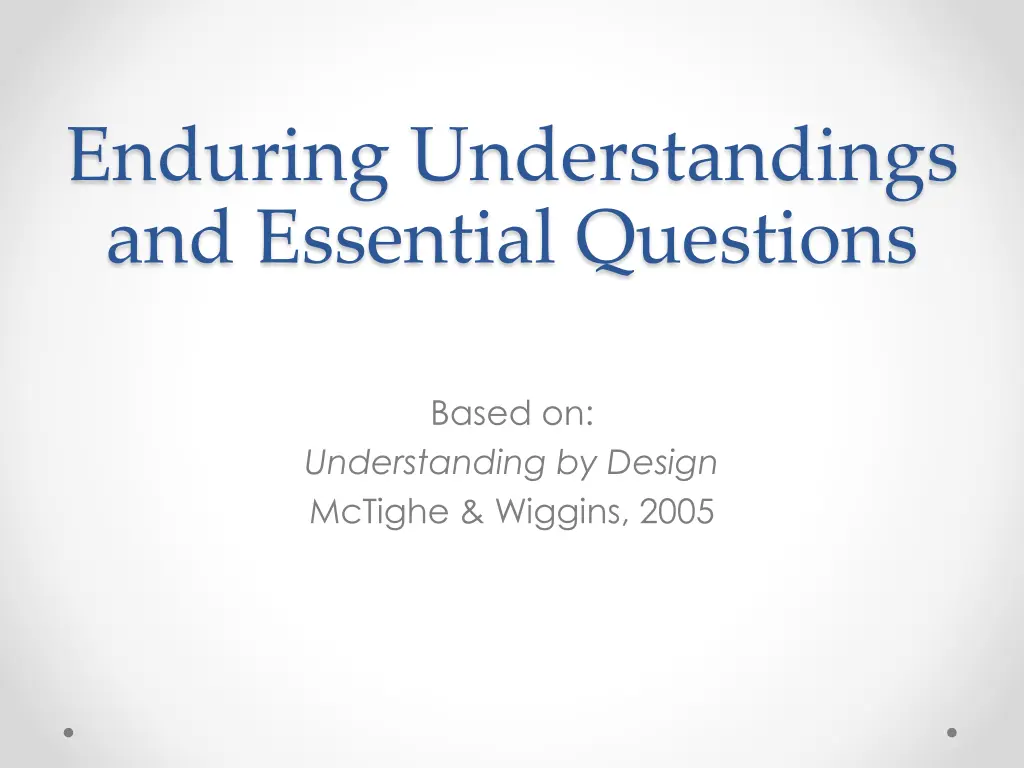
Understanding Enduring Understandings & Essential Questions
Gain insight into enduring understandings and essential questions based on McTighe & Wiggins’ Understanding by Design framework. Discover the importance of developing students' understanding of key ideas and processes in education to enable transfer of learning. Explore the distinction between enduring understandings and essential questions, and their role in guiding inquiry and learning.
Download Presentation

Please find below an Image/Link to download the presentation.
The content on the website is provided AS IS for your information and personal use only. It may not be sold, licensed, or shared on other websites without obtaining consent from the author. If you encounter any issues during the download, it is possible that the publisher has removed the file from their server.
You are allowed to download the files provided on this website for personal or commercial use, subject to the condition that they are used lawfully. All files are the property of their respective owners.
The content on the website is provided AS IS for your information and personal use only. It may not be sold, licensed, or shared on other websites without obtaining consent from the author.
E N D
Presentation Transcript
Enduring Understandings and Essential Questions Based on: Understanding by Design McTighe & Wiggins, 2005
The Lancaster School District Approach CCSS ELA Essential Question 1 Teacher Developed CA Content Standards Unit CCSS ELA Enduring Understanding Essential Question 2 Teacher Developed Standard Across District CA Content Standards CCSS ELA Essential Question 3 Teacher Developed CA Content Standards Based on the work of McTighe & Wiggens, 2013
education should strive to develop and deepen students' understanding of important ideas and processes so that they can transfer their learning within and outside school. Accordingly, we recommend that content (related goals) be unpacked to identify long-term transfer goals and desired understandings. McTighe & Wiggins, 2013
What is an Enduring Understanding? Enduring Understandings are the specific insights, inferences, or conclusions about the important big ideas, residing at the heart of all disciplines, that we want students to learn. They are: o Timeless o Cut across topics o Abstractions, rather than facts o Not teachable in the conventional sense
What are Essential Questions? Essential Questions: are derived from Enduring Understandings. help guide students through the process of inquiry. prompt guided inference whereby the student must make, recognize, or verify a conclusion. help students construct meaning out of abstract notions and ideas. lead students to the Enduring Understanding.
Enduring Understanding vs. Essential Questions Enduring Understandings Many factors, such as geography, climate, and natural resources impact the economy and lifestyle of the people living in a particular region. Essential Questions How does where you live influence how you live? Understanding the impact of the environment and its influence on humans allows us to adapt to our surroundings. How does the movement of water through an environment affect humanity for the people living there?
What makes a question essential? From McTighe & Wiggins, 2013 Essential Questions How do the arts shape, as well as reflect, a culture? Not Essential Questions What common artistic symbols were used by the Incas and the Mayans. What do effective problem solvers do when they get stuck? What steps did you follow to get your answer? Is there ever a just war? What key event sparked World War I? What characteristics define a true friend? Which person is a true friend to Maggie in the story?
Two Types of Essential Questions Overarching Essential Questions How does perspective change how a story is told? Topical Essential Questions How did the Native Americans of southern California view the settlement of their land? What does the architecture of ancient Athens reveal about the culture of that time? In what ways does art reflect, as well as shape, culture? How does J.D. Salinger create mood in his novel, Catcher in the Rye? What various story elements do authors use to develop mood? How do various body systems interact? What makes up a system?
Is it an essential question? 1. Is it open-ended? 2. Is it thought-provoking? 3. Does it call for higher-order thinking, such as analysis, inference, evaluation, and/or prediction? 4. Does it point toward important, transferable ideas (i.e., The Enduring Understanding)? 5. Does it raise additional questions and spark further inquiry? 6. Does it require support and justification? 7. Does it recur over time?
Activity Work in pairs. Read each question and determine whether or not it is an essential question. Rewrite non-essential questions to make them essential.
Why do we use Essential Questions? Promote inquiry as a key goal of our instruction. Increase the intellectual engagement of our units. Organize standards within each unit. Encourage and model metacognition for students.
How to use Essential Questions Step 1: Introduce the Essential Question to the students. Step 2: Use DOK questioning strategies to elicit varied responses from your students. Ask students to predict an answer to the question or to make a personal connection. Step 3: Introduce and explore new perspectives as you teach your content (this is where the majority of your time is spent). Step 4: Reach tentative closure by asking students to generalize their findings. Students revisit and affirm or revise their original predictions or connections.
The 1st Step in Unit Planning 1. Review your unit s Enduring Understanding. 2. Examine the standards you should be teaching according to the YAAG. 3. Organize your standards into logical groups. 4. Write an Essential Question for each group of standards that connects the Enduring Understanding to the CCSS and content standards.

